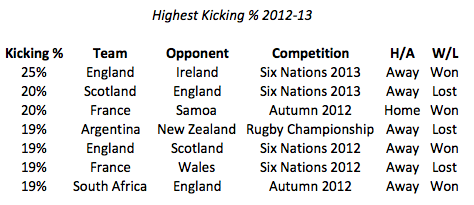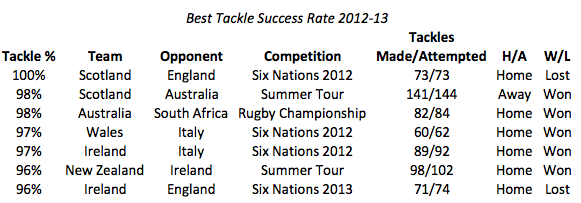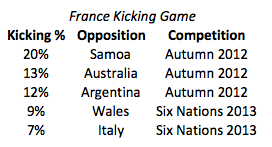Six Nations Week 2: English discipline and lazy thinking about the French
From the sublime to the ridiculous. Whereas the opening weekend of the 2013 championship brought tries and points by the bagful, the second weekend was quick to bring balance to the force.
Having written on Saturday that fans shouldn’t expect a repeat of that sort of try-scoring craziness… well… ten to twelve tries, I thought. It turned out to be only marginally more optimistic than economists’ predictions that the Irish housing bubble would result in a “soft landing”.
The first game of the weekend was the battle of the blues* in Murrayfield. Scotland’s match against Italy saw 5 tries but between the French, the Welsh, the English and the Irish there was one solitary five-pointer witnessed over the remaining two games. That’s six tries. In total. In three test matches.
*Dear Scotland powers-that-be, on Saturday your national side faced a team wearing blue. Your usual kit is navy with gold trim so you decide to wear your change kit of white. Here’s a nice photo of it on launch day.
Note the blue on the jersey, a jersey you only ever wear against teams wearing blue. Note the white shorts, which were so oddly replaced by shorts of an identical hue to both the blue on the jersey and the Italian kit. But I’m sure you knew best.
On to the weekend’s games.
Ireland vs. England
After making 200 tackles against Wales (revised upwards in the post-match analysis from the 176 originally recorded), against England the Irish players were called upon just 76 times in this regard. That’s fewer than one tackle per minute. Wales, of course, had kept ball in hand far more than the English, whose gameplan was far more dependent on field position and defence than trying to make breaks.
England kicked 40 times against Ireland; that’s a massive 25% of all possessions. That’s the most in any test match played in 2012 or thus far in 2013. And by some way. Against Scotland last week England had kicked just 7% of ball. This was a very obvious change in tactics, a change that was implemented with a dogmatic fervour by Stuart Lancaster’s young halves.
England’s gameplan was simple, disciplined and pragmatic. Only twice in the entire game did they take what one might have thought to be a risk; the first a cross-kick to Chris Ashton but against weak Irish cover; the second a Farrell chip to an onrushing Tuilagi – but even then it came on a free play with Garces holding his hand out for an English penalty advantage.
Over a dreary afternoon in Dublin the English kicked the ball to Ireland and set themselves up to absorb the attack. In NFL-parlance it was a “prevent” defence, perfectly happy to cede Ireland a yard or two each time, allowing the green shirts to shuffle sideways across the pitch but not allowing the big break.
And it worked.
According to RuckinGoodStats, Ireland spent just 44 seconds (yes, seconds) in England’s 22 during the second half of Sunday’s soggy contest at Lansdowne Road.
When an Irish player went into contact the English players were incredibly well-drilled at not getting sucked into the fringes of the contest area. Much of the time there was just one man on his feet on the English side; this man’s primary role was not to compete for the ball at all costs (unless it was a near certainty he’d win at least a penalty), rather he was there to do the bare minimum to ensure that a ruck was technically formed*. Every other English jersey apart from the tackler(s) and full-back was strung out across the full width of the pitch. Sometimes this was brought even further and no English player bothered to even contest the ruck at all.
*if there was no ruck formed then an Irish support player could pick up the ball from the tackle area and run straight through.
It was a simple, disciplined approach and on a messy day and on a soft pitch it worked exceedingly well. It might possibly have reminded both Leinster and Munster fans of too many crablike days this season, watching their sides shuffle left and right without penetration.
In making an unacceptable number of handling errors Ireland was Stuart Lancaster’s perfect dance partner. The English coach led; Ireland tamely followed. England continued their soak-up-the-pressure-and-wait-
It wasn’t all bad for Ireland, whose play without the ball was genuinely excellent. They were called upon to make just 74 tackles of which they made 71. That tackle rate of 96% was superb. And like the English, green shirts were disciplined at not getting sucked in to tight areas.
England didn’t make a single line break in the game, but in fairness they weren’t really trying to. Ben Youngs and Owen Farrell kicked Ireland back into their own half again and again, with first Jonathan Sexton and then Ronan O’Gara* guilty of not showing the nous to do the same for Ireland.
*As an aside, if Ronan O’Gara can’t pin back a callow England team in a home international on a wet track, even his most ardent defenders must surely be questioning his worth in an Irish jersey.
Ireland made just two line breaks on Sunday, both on the left touchline from Keith Earls who had come into the game to replace the injured Simon Zebo. Both breaks were similar in nature with well-timed passes from Murray and then Brian O’Driscoll putting the Munsterman away courtesy of Earls’ excellently timed running onto the pass on both occasions. Both breaks were facilitated by having a momentary attacking overlap, something rarely seen in the game.
One slightly concerning aspect of Ireland’s second half in Wales, the entire match against England on Sunday and the second half of their Autumn loss to South Africa was an apparent inability to change strategy based on what was happening in the game. Momentum is important in sport; if that momentum is unfavourable then it’s up to coach and captain to affect a change in the tide. On all three occasions (South Africa, Wales, England) that kind of on-the-fly game changing leadership didn’t seem to be present.
Scotland vs. Italy
Having spent enough time talking about England and Ireland, it’s worth spending a few moments discussing the Italians. On another day that could have been a very tight game in Murrayfield. The Scots continued their emphasis on the boot, kicking 16% of ball. The Italians kicked just 7% of ball, were allowed 62% of both possession and territory and weren’t out of touch until that one excruciating moment that resulted in the Italian out half getting the hook. Orquera’s pass, intercepted by Hogg, resulted in a fourteen point swing that ended the match as a meaningful contest.
The Italian set piece was excellent, winning all nine of their own scrums and losing just one of 11 lineouts. Unfortunately this was undone by the Italian tackling on the day which was rank awful and they turned over the ball a comical 19 times. That’s a recipe for disaster, and so it proved.
Against a poor French team everything went right for Italy; against a poor Scotland team not much went right at all. Their true talent probably lies somewhere in between and it would not be surprising to see them run someone else very close or even grab another win in this championship.
France vs. Wales
France against Wales is worth just two comments; one short and one somewhat longer:
Firstly, the late try by George North was an act of of precision and grace, two qualities notable for their almost complete absence in the match in which it was scored.
Secondly, it’s worth pointing out that some of the commentary complaining about the French style of play is a bit lazy. Complain about their execution, fine. But complaining that they’re suddenly kicking too much and going away from the traditional French ethos?
Fact is, the French kicked solidly all through the Autumn tests.
Their big win against Australia is often brought up as the “evidence” that they were playing “French” rugby, meaning open running and passing rugby.
Yep, they hockeyed the Wallabies 33-6. Can’t be denyed.
But weren’t running willy-nilly. Rather the Aussies were.
France kicked 13% of ball compared to Australia’s 4%; the latter figure was the second-lowest figure in any test match played in 2012. They conceded possession and territory to the Australians then made 177 tackles at a 93% success rate and destroyed the Australian scrum on the day.
And the Australians made 24 turnovers.
No top-tier test nation made more turnovers in any match in 2012.
Eight of these turnovers were forced by the French (stat from Opta), a decent amount but not stupidly large, whereas a full 16 turnovers were the Australians’ own work.
The French capitalised on all of the above in somewhat ruthless fashion.
In the Autumn the French kicked 13% against Australia, 12% against Argentina and a massive 20% against Samoa who were desperately unlucky not to win on the day.
It’s odd how the same commentators who have held up the French win over Australia as some sort of rugby nirvana haven’t really mentioned that Samoa match. It was an absolute dogfight of a game, and the Samoans should have won it. They outscored the French two tries to one but gave up penalties in kickable positions that Michalak and Parra nailed.
France kicked 20% of ball to the Samoans, conceding 72% of territory and 74% of possession, and sat back to tackle for their lives. The Samoans were asked to make just 53 tackle attempts that day, compared to the 168 attempts of the French.
The French set piece was ruthlessly efficient, winning all six scrums and 12 lineouts. And just like the Australia match they destroyed the opposition scrum and robbed three Samoan lineouts for good measure. But unlike the Australia match this time the French themselves coughed up 21 turnovers themselves. They were lucky. Very, very lucky.
So when wondering about the French this spring, don’t obsess with the amount of kicking done.
Against Italy, France kicked just 7% of ball.
Against Wales, they kicked 9%.
They’re kicking less than last autumn, when of course they were back to their “magnificent best”. Instead, like Michalak’s limp flick over a Welsh midfield with no supporting runners, focus on the (lack of) quality of those kicks, the set piece and winning the turnover battle.




